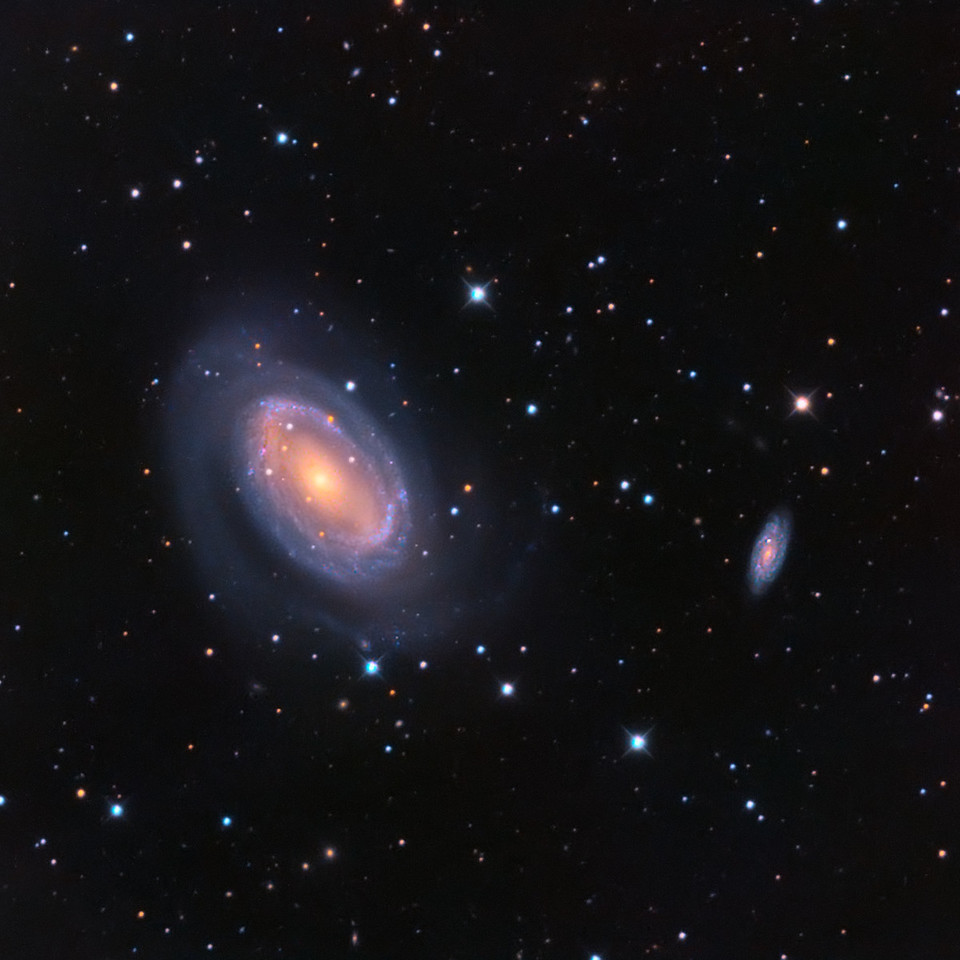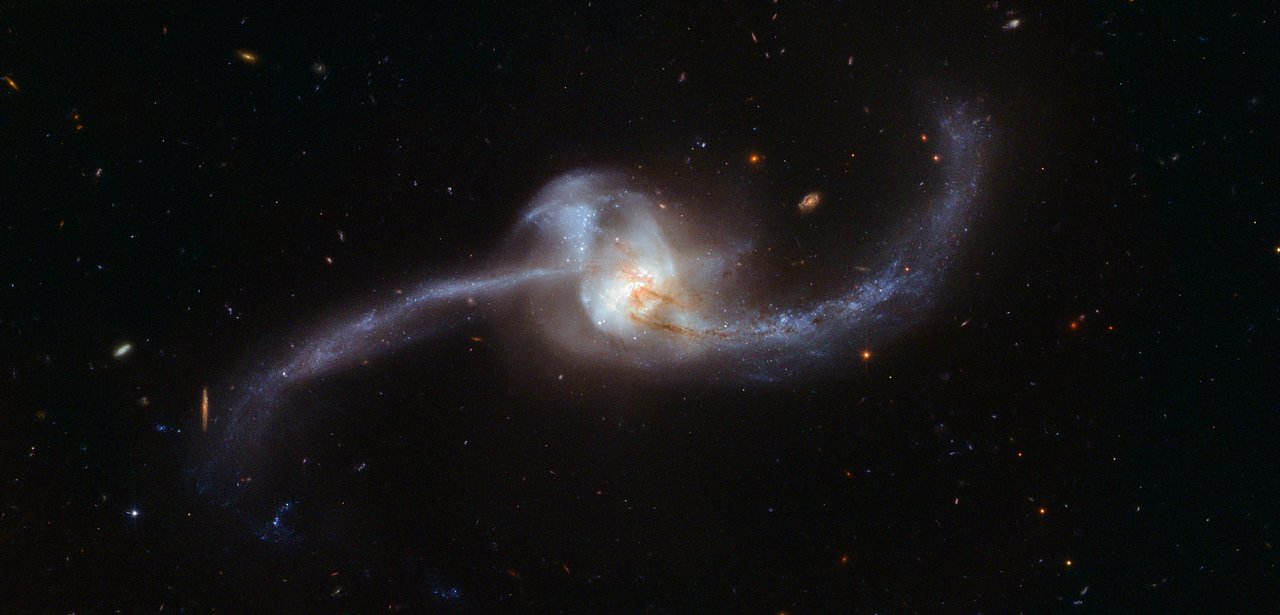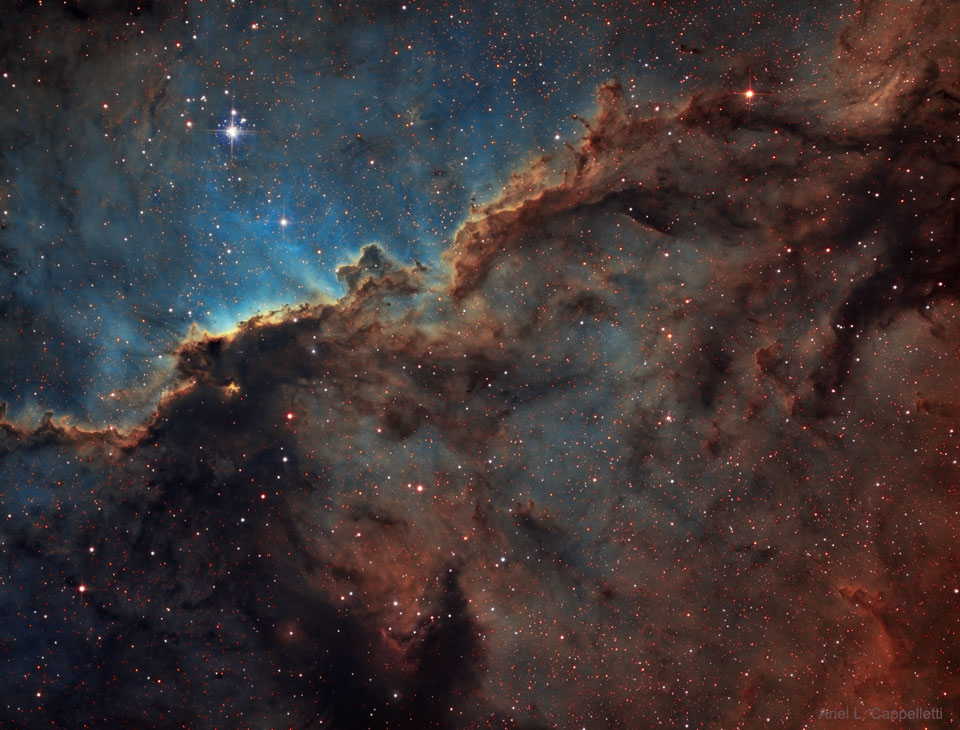Blog
Orchestra Baobab’s Balla Sidibe, a ‘giant’ of music, dies.
Balla Sidibe, a founding member and singer of the legendary Senegalese group Orchestra Baobab, has died in Dakar.
Sidibe died in his sleep “after a very full day of rehearsals with his musical comrades”, Senegal’s music association said in a statement, adding that it had lost “a father, a sage and a friend”.
Local media said Sidibe, who was also a percussionist, died after “a short illness”, without giving further details. He was in his 60s.
Established in 1970, Orchestra Baobab fused Cuban rhythms, soul and jazz with traditional music from Senegal and other parts of Africa to become one of the most successful groups to emerge from the time.
https://www.youtube.com/watch?v=ADRIod6b690
more...While most spiral galaxies, including our own Milky Way, have two or more spiral arms, NGC 4725 has only one. In this sharp color composite image, the solo spira mirabilis seems to wind from a prominent ring of bluish, newborn star clusters and red tinted star forming regions. The odd galaxy also sports obscuring dust lanes a yellowish central bar structure composed of an older population of stars. NGC 4725 is over 100 thousand light-years across and lies 41 million light-years away in the well-groomed constellation Coma Berenices.

David William Sanborn (born July 30, 1945) is an American alto saxophonist. Though Sanborn has worked in many genres, his solo recordings typically blend jazz with instrumental pop and R&B. He released his first solo album Taking Off in 1975, but has been playing the saxophone since before he was in high school.
One of the most commercially successful American saxophonists to earn prominence since the 1980s, Sanborn is described by critic Scott Yannow as “the most influential saxophonist on pop, R&B, and crossover players of the past 20 years.” He is often identified with radio-friendly smooth jazz, but he has expressed a disinclination for the genre and his association with it.
Sanborn was born in Tampa, Florida, and grew up in Kirkwood, Missouri. He suffered from polio for eight years in his youth. He began playing saxophone on a physician’s advice to strengthen his weakened chest muscles and improve his breathing. Alto saxophonist Hank Crawford, at the time a member of Ray Charles‘s band, was an early and lasting influence on Sanborn.
Sanborn attended college at Northwestern University and studied music. But he transferred to the University of Iowa where he played and studied with saxophonist J.R. Monterose.
more...George “Buddy” Guy (born July 30, 1936) is an American blues guitarist and singer. He is an exponent of Chicago blues and has influenced guitarists including Eric Clapton, Jimi Hendrix, Jimmy Page, Keith Richards, Stevie Ray Vaughan, Jeff Beck, Gary Clark Jr. and John Mayer. In the 1960s, Guy played with Muddy Waters as a house guitarist at Chess Records and began a musical partnership with the harmonica player Junior Wells.
Guy was ranked 23rd in Rolling Stone magazine’s “100 Greatest Guitarists of All Time“. His song “Stone Crazy” was ranked 78th in the Rolling Stone list of the “100 Greatest Guitar Songs of All Time”. Clapton once described him as “the best guitar player alive”. In 1999, Guy wrote the book Damn Right I’ve Got the Blues, with Donald Wilcock. His autobiography, When I Left Home: My Story, was published in 2012.
Guy was born and raised in Lettsworth, Louisiana. His parents were sharecroppers and as a child, Guy would pick cotton for $2.50 per 100 pounds. He began learning to play the guitar using a two-string diddley bow he made. Later he was given a Harmony acoustic guitar which, decades later in Guy’s lengthy career, was donated to the Rock and Roll Hall of Fame.
more...Vernel Anthony Fournier (July 30, 1928 – November 4, 2000) and, from 1975, known as Amir Rushdan, was an American jazz drummer probably best known for his work with Ahmad Jamal from 1956 to 1962.
Fournier was born in New Orleans, Louisiana, into a Creole family. He left college to join a big band led by King Kolax. After Kolax downsized to a quintet, Fournier moved to Chicago in 1948, where he played with such musicians as Buster Bennett, Paul Bascomb and Teddy Wilson. As house drummer at the Bee Hive club on Chicago’s South Side in 1953-55, he accompanied many visiting soloists, including Lester Young, Ben Webster, Sonny Stitt, J.J. Johnson, Earl Washington and Stan Getz.
From 1953 to 1956, Fournier also worked many recording sessions with Al Smith, Red Holloway, Lefty Bates, and others. He joined Ahmad Jamal’s trio in 1957, along with bass player Israel Crosby, and remained with the group until 1962, appearing on a series of recordings for the Chess label. The best known of these, At the Pershing: But Not for Me (1958), became one of the best selling jazz records of all time, remaining on the Billboard jazz charts for over two years.
After leaving the Jamal trio, Fournier joined George Shearing for two years before rejoining Jamal briefly in 1965-66. He then took a long-running gig with a trio at a restaurant owned by Elijah Muhammad.
He converted to Islam in 1975, and took the Muslim name of Amir Rushdan.
He worked with Nancy Wilson, Clifford Jordan, Billy Eckstine and Joe Williams, John Lewis and Barry Harris. Fournier was also a teacher of drumming, working at Barry Harris’s Jazz Cultural Theater, the New School, and the Mannes College of Music.
more...This image, captured by the NASA/ESA Hubble Space Telescope, shows what happens when two galaxies become one. The twisted cosmic knot seen here is NGC 2623 — or Arp 243 — and is located about 250 million light-years away in the constellation of Cancer (The Crab).
NGC 2623 gained its unusual and distinctive shape as the result of a major collision and subsequent mergerbetween two separate galaxies. This violent encounter caused clouds of gas within the two galaxies to become compressed and stirred up, in turn triggering a sharp spike of star formation. This active star formation is marked by speckled patches of bright blue; these can be seen clustered both in the centre and along the trails of dust and gas forming NGC 2623’s sweeping curves (known as tidal tails). These tails extend for roughly 50 000 light-years from end to end. Many young, hot, newborn stars form in bright stellar clusters — at least 170 such clusters are known to exist within NGC 2623.
NGC 2623 is in a late stage of merging. It is thought that the Milky Way will eventually resemble NGC 2623 when it collides with our neighbouring galaxy, the Andromeda Galaxy, in four billion years time.
In contrast to the image of NGC 2623 released in 2009 (heic0912), this new version contains data from recent narrow-band and infrared observations that make more features of the galaxy visible.

Joe Beck (July 29, 1945 – July 22, 2008) was an American jazz guitarist who was active for over 30 years.
Born in Philadelphia, Beck moved to Manhattan in his teens, playing six nights a week in a trio setting, which gave him an opportunity to meet various people working in the thriving New York music scene. By the time he was 18, Stan Getz hired him to record jingles, and in 1967 he recorded with Miles Davis. By 1968, at age 22, he was a member of the Gil Evans Orchestra.
https://www.youtube.com/watch?v=1kqm3LHosKs
more...Charles Henry Christian (July 29, 1916 – March 2, 1942) was an American swing and jazz guitarist.
Christian was an important early performer on the electric guitar and a key figure in the development of bebop and cool jazz. He gained national exposure as a member of the Benny Goodman Sextet and Orchestra from August 1939 to June 1941. His single-string technique, combined with amplification, helped bring the guitar out of the rhythm section and into the forefront as a solo instrument. John Hammond and George T. Simon called Christian the best improvisational talent of the swing era. In the liner notes to the album Solo Flight: The Genius of Charlie Christian (Columbia, 1972), Gene Lees wrote that “Many critics and musicians consider that Christian was one of the founding fathers of bebop, or if not that, at least a precursor to it.”
Christian’s influence reached beyond jazz and swing. In 1990, he was inducted into the Rock and Roll Hall of Fame in the category Early Influence.
In 2006 Oklahoma City renamed a street in its Bricktown entertainment district “Charlie Christian Avenue” (Christian was raised in Oklahoma City and was one of many musicians who jammed along the city’s “Deep Deuce” section on N.E. Second Street).
Christian was born in Bonham, Texas. His family moved to Oklahoma City, Oklahoma, when he was a small child. His parents were musicians. He had two brothers, Edward, born in 1906, and Clarence, born in 1911. All three sons were taught music by their father, Clarence Henry Christian. Clarence Henry was struck blind by fever, and in order to support the family he and the boys worked as buskers, on what the Christians called “busts.” He would have them lead him into the better neighborhoods, where they would perform for cash or goods. When Charles was old enough to go along, he first entertained by dancing. Later he learned to play the guitar, inheriting his father’s instruments upon his death when Charles was 12.
https://www.youtube.com/watch?v=IID2JPnGF00
more...Donald Matthew Redman (July 29, 1900 – November 30, 1964) was an American jazz musician, arranger, bandleader, and composer.
Redman was born in Piedmont, Mineral County, West Virginia. His father was a music teacher, his mother was a singer. Don began playing the trumpet at the age of three, joined his first band at the age of six and by the age of 12 was proficient on all wind instruments ranging from trumpet to oboe as well as piano. He studied at Storer College in Harper’s Ferry and at the Boston Conservatory, then joined Billy Page’s Broadway Syncopaters in New York City. He was the uncle of saxophonist Dewey Redman, and thus great-uncle of saxophonist Joshua Redman and trumpeter Carlos Redman.
more...https://www.youtube.com/watch?v=rGJcbHni4rc
more...NGC 6188 are tens of light-years long. The emission nebula is found near the edge of an otherwise dark and large molecular cloud in the southern constellation Ara, about 4,000 light-years away. Born in that region only a few million years ago, the massive young stars of the embedded Ara OB1 association sculpt the fantastic shapes and power the nebular glow with stellar winds and intense ultraviolet radiation. The recent star formation itself was likely triggered by winds and supernova explosions, from previous generations of massive stars, that swept up and compressed the molecular gas. The featured image accumulated over 10 hours through a backyard telescope in Córdoba, Argentina and was false-colored using the Hubble palette highlighting emission from sulfur, hydrogen, and oxygen atoms in red, green, and blue hues. The field of view spans about four full Moons, corresponding to about 150 light years at the estimated distance of NGC 6188.

Delfeayo Marsalis (/ˈdɛl fiː oʊ/; born July 28, 1965) is an American jazz trombonist, record producer and educator.
Marsalis was born in New Orleans, the son of Dolores (née Ferdinand) and Ellis Louis Marsalis, Jr., a pianist and music professor. He is also the grandson of Ellis Marsalis, Sr., and the brother of Wynton Marsalis (trumpeter), Branford Marsalis (saxophonist), and Jason Marsalis (drummer). Delfeayo also has two brothers who are not musicians: Ellis Marsalis III (b. 1964) is a poet, photographer and computer networking specialist based in Baltimore, and Mboya Kenyatta (b. 1970) is autistic and was the primary inspiration for Delfeayo’s founding of the New Orleans-based Uptown Music Theatre. Formed in 2000, UMT has trained over 300 youth and staged eight original musicals, all of which are based upon the mission of “community unity”.
more...Michael Bernard Bloomfield (July 28, 1943 – February 15, 1981) was an American guitarist and composer, born in Chicago, Illinois, who became one of the first popular music superstars of the 1960s to earn his reputation almost entirely on his instrumental prowess, since he rarely sang before 1969. Respected for his guitar playing, Bloomfield knew and played with many of Chicago’s blues musicians before achieving his own fame and was instrumental in popularizing blues music in the mid-1960s. He was ranked No. 22 on Rolling Stone‘s list of “100 Greatest Guitarists of All Time” in 2003 and No. 42 by the same magazine in 2011. He was inducted into the Blues Hall of Fame in 2012 and, as a member of the Paul Butterfield Blues Band, was inducted into the Rock and Roll Hall of Fame in 2015.
Bloomfield was born into a wealthy Chicago Jewish-American family. Bloomfield’s father, Harold Bloomfield, was born in Chicago in 1914. After pursuing business ventures in California during the 1920s, he returned to the city in the early 1930s. Harold Bloomfield began manufacturing restaurant supplies, and by the latter part of the decade his company, Bloomfield Industries, was making pie cases, kitchen utensils, salt and pepper shakers, and sugar pourers. By the early 1940s Bloomfield Industries had acquired more manufacturing and warehouse space. The company expanded during World War II by manufacturing supplies needed for the war effort. Working with his brother, Daniel, and his father, Samuel, Harold Bloomfield built up Bloomfield Industries into a thriving business. Michael Bloomfield’s mother was born Dorothy Klein in Chicago in 1918 and married Harold Bloomfield in 1940. She came from an artistic, musical family, and worked as an actor and a model before marrying Bloomfield.
more...Jimmy “Duck” Holmes (born July 28, 1947) is an American blues musician and proprietor of the Blue Front Cafe on the Mississippi Blues Trail, the oldest surviving juke joint in Mississippi. Holmes is known as the last of the Bentonia bluesmen, as he is the last blues musician to play the Bentonia School. Like Skip James and Jack Owens and other blues musicians from Bentonia, Mississippi, Holmes learned to play the blues from Henry Stuckey, the originator of the Bentonia blues. Holmes’ music is based in the Bentonia tuning utilizing open E-minor, open D-minor and a down tuned variant, and is noted for its haunting, ethereal, rhythmic and hypnotic qualities. His eighth album, It Is What It Is, on Blue Front Records has been praised by fans and music critics who have called it: “addictive” and “obsession worthy,” “as gritty, stark and raw as one could imagine” and “absolutely hypnotic,” and “an essential modern recording.”
Jimmy Charles Holmes was born in Yazoo County, Mississippi, United States, to Carey and Mary Holmes at their home in Bentonia, Mississippi. Holmes’ parents were sharecroppers, who opened the Blue Front Cafe in 1948, the year after he was born. They had ten children, but also raised four grandchildren when one of their daughters died.
more...More Posts
- Walter Perkins Day
- Chick Webb Day
- World Music with Princess Fatu Gayflor
- Daily Roots with Bob Marley
- MAROONS 2-10-18
- The Cosmos with NGC 5033
- Carole King Day
- Javier Perez Forte Day
- Peanuts Holland Day
- Walter Page Day
- World Music with José Antonio Rodríguez
- Daily Roots with Jennifer Lara
- The Cosmos with NGC 6118
- Floyd Dixon Day
- Eddie Locke Day
- Lonnie Johnson Day
- World Music with Innov Gnawa
- Daily Roots with Bob Marley
- RHYTHM ROOTS WORKSHOP 2-7-18
- The Cosmos with NGC 7331